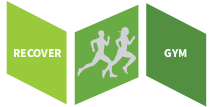Repetitive strain injury (RSI) / Myositis / work-related upper limb disorder / non-specific upper limb pain
Description of Repetitive strain injury
An injury caused by office / computer work can have many different characteristics. Typically, one gets pain from the neck and down to the fingers, especially in the arm which controls the mouse or is used in the work. The pain is due to a reflective tension of the overused muscle groups. The muscles are designed for use during contraction with a following relaxation – for a full day’s work at the office, this relaxation is only allowed to a small extent and therefore waste materials in these muscles begin accumulating. Eventually swelling occurs locally in the muscles called myositis.
There are typically three causes when it comes to Repetitive strain injury:
Cause:
-
- A relatively short time after the work has started with the mouse.
- After transitioning to a new system / version.
- After / or during a very busy period where many hours are required in front of the computer.
Cause: A combination of physical and mental influences.
-
- A second cause is where the injury occurs after years of work in the office.
- First as soreness, which is initially expected to alleviate.
- Later as pain combined with various types of inflammation e.g. tennis elbow, bursitis, or nerve problems.
Cause: Long-term wear and tear because of unilaterally repeated work and poor ergonomics at the work plae.
Symptoms of repetitive strain injury
- Sore neck, shoulders, arms and wrists.
- Træthed i nakke, skuldre og arm.
- Pain in the neck, shoulders, arm, elbow, wrist and headache.
- Increased pain at continued use.
- Relief with rest.
Examination of repetitive strain injury
- Analysis / Inspection / Palpation / ROM Test of Power and Passive and Active Motion.
- Compression and traction test of the neck especially if experiencing radiating pain in the arm.
- Palpation of the neck, shoulders (especially Rotator Cuff muscles) and arm.
- Trigger point localization in the muscles.
- Shoulder blade – rhythm of the upper arm is observed.
Treatment of repetitive strain injury
- Rehab training (see below).
- Massage of the shoulders, neck and upper back.
- Possibly massage of arm
- Trigger point pressure on the relevant muscle groups – depending on syndrome e.g. trapezius syndrome, levator scapulae syndrome, supraspinatus syndrome or rhomboids syndrome.
- Scapula / shoulder blade mobilization.
- Stretching.
- Workplace assessment for ergonomics – e.g. table / chairs height.
- Spascupreel. (2 tabl. 3 g. daily for 9 days).
- Ultrasound (continuous / pulsating), Mhz dependent on which muscle.
- TNS.
- Kinesiology tape
- K-Laser.
Rehab training for repetitive strain injury
If you have a specific injury like tennis elbow, neck pain or shoulder pain as a result of repetitive strain injury, you should find this specific injury on the rehabilitation page and do the program for that specific injury. Further, you should look at your sitting position while at work and / or intensity in order to locate provoking factors for the pain / strain. Straighten sitting positions through the day, avoid static positions of neck and shoulders for a long time without movement, avoid too much work with mouse / keyboard etc. over time without moving and pause. Create as much movement and blood circulation throughout the day as possible. This program is an office related program that you can use for rehabilitation and prevention of future injury and pain. Office work and related issues.

Social Medier